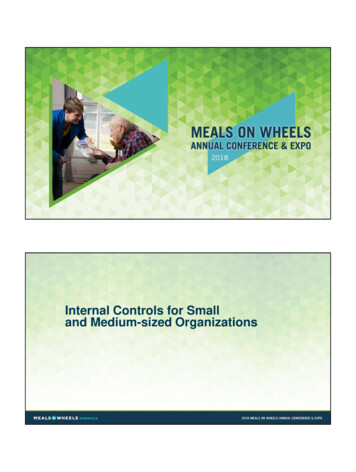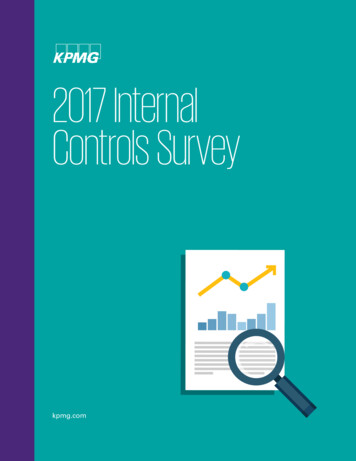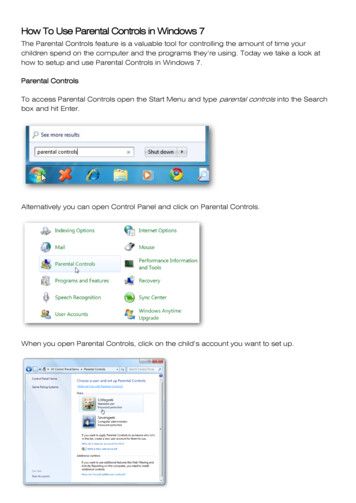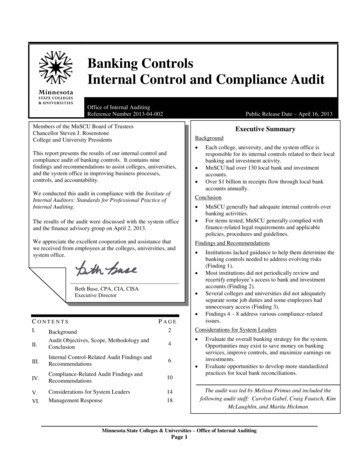
Transcription
Internal Controls for Smalland Medium-sized Organizations
Internal Controls for Small and Medium-sizedOrganizationsPresenterChris Cole, CPA, CGMA, CFE, CFFAssociate Director,Engagement and Learning InnovationLearning Objectives How to design controls, keeping in mind the COSOframework How to assign responsibility for oversight of controlsimplementation How to assess the effectiveness of controls View examples of control activities Answer your questions and discuss real-world application insmaller organizations
What are internal controls?“And why do I care?”Internal Controls - definitionA process*, effected by an entity's board of directors,management and other personnel, designed to providereasonable assurance regarding the achievement of objectivesin the following categories: Effectiveness and efficiency of operations Reliability of financial reporting Compliance with applicable laws and regulations*Embedded within this process are controls included in policies and procedures.
Why do I need internal controls? Reduces possibility of mismanagement, error and fraudImproves quality of informationReduces possibility of material misstatement in financial statementsProtects your organization to reduce risk of lossProvides consistent practices to be followed by personnelCop OutsDon’t fix what’s not broken.Let sleeping dogs lie.That’s above my paygrade.We’ve always done it that way.This is just unnecessary red tape.It doesn't matter; what I do is just a drop in the bucket.Do you not trust me to do my job?
Why do I need internal controls? Reducesopportunities forindividuals tocommit fraudRationalizationExamples of control activitiesAuthorization Review by appropriateindividualsRetention of records Substantiation oftransactionsSupervision Review or observation ofprocessesMonitoring Ongoing evaluation toensure controls areoperating as intendedPhysical security of assets Protecting property,equipment and inventorySegregation of duties Different individuals performauthorization, custody andrecord-keeping
Types of controlsEntity-level Includes tone setting, oversightby board and seniormanagement, governancepolicies, procedures andpractices that affect the entireorganization (within and outsideof the financial function)Preventative To keep errors or fraud fromhappening from the onsetDetective To detect an error or fraud afterit has occurred (before itbecomes a major problem)Automated Refers to triggers embeddedwithin (or configurable) within ITsystemManual Requires persons to performfunctionsWho’s responsible for internal controls?Governing board Provides governance, guidance and oversightManagement Accountable to the board of directorsStaff Are involved in producing information/taking actions within the environmentResponsible for communicating problems in operationsInternal Auditors (in larger organizations) Play a monitoring roleVirtually everyone within an organization!
Who’s not responsible for internal controls? External independentauditors Outsourced serviceprovidersControls are not “one size fits all” – theyshould be developed based on the risksand characteristics of the organization
How do I design and implement controls?Best place to start? Use the COSO Internal ControlFrameworkCOSO Framework“What is it and what makes it the goldstandard of internal control?”
What is the COSO Framework? Dynamic and on-going process Responsibility of everyone Satisfies objectives Operating Reporting ComplianceWhy do we have COSO?Committee of Sponsoring Organizations of theTreadway Commission 1992: Internal Control – Integrated Framework 2001: Enterprise Risk Management – Integrated RiskFramework 2013: Internal Control – Integrated Framework
Need for a FrameworkChanges inTechnology and RisksIncreased expectationof internal controls &auditorsChanginginterdependence oforganizationsIncreased importanceof complianceactivitiesCOSO Framework
COSO Components & PrinciplesControl EnvironmentRisk AssessmentControl ActivitiesInformation &CommunicationMonitoring Activities1.2.3.4.5.Demonstrates commitment to integrity and ethical valuesExercises oversight responsibilityEstablishes structure, authority and responsibilityDemonstrates commitment to competenceEnforces accountability6.7.8.9.Specifies suitable objectivesIdentifies and analyzes riskAssesses fraud riskIdentifies and analyzes significant change10. Selects and develops control activities11. Selects and develops general controls over technology12. Deploys through policies and procedures13. Uses relevant information14. Communicates internally15. Communicates externally16. Conducts ongoing and/or separate evaluations17. Evaluates and communicates deficienciesBenefits of COSO Reliable financial reportingConsistent transaction processingIncreased efficiencyRational basis for decision makingIncrease confidence in information reporting
Key Control Objectives for Smaller NFPs Controls over cash receipts to prevent skimmingControls over cash disbursements to prevent unauthorizeddisbursementsControls over periodic (monthly) financial reports to ensure accuratefinancial reportingControls OverCash Disbursements
What is a smaller entity? Annual budget of less than 10,000,000 Finance office consists of one, two, or three peopleControls Over Cash DisbursementsThe questions! If anyone generated anunauthorizeddisbursement, wouldanyone other than theperpetrator know about it?How soon would theydetect it?
Disbursements – Controls That Don’t WorkTwo signatures on every check. This may be a good control for otherreasons, but it does not help prevent fraud.Banks don’t look at signatures on checks.Someone other than the bookkeeperperforms the bank reconciliation. Only if this person looks at eachdisbursement and determines that it wasproperly authorized.Payees on checks could have beenchanged in the accounting system.ED approves all disbursements. All but the fraudulent ones!!Controls Over Cash DisbursementsThe Answers! If the perp was someoneother than the bookkeeper,then the bookkeeper wouldlikely detect it when thebookkeeper performs thebank reconciliation. “What is this deductionfrom the bank that hasnot been entered into theaccounting system?”
Controls Over Cash Disbursements What if the perp is the bookkeeper? Who would catch that? It’s usually the bookkeeper who ends up getting away with fraud – for awhile. Would the ED catch it if the ED reviews the bank reconciliation? Depends on the quality of the review.Controls Over Cash Disbursements (continued) For smaller organizations, someone other than the bookkeeper needs toreview every disbursement from the bank accounts Someone other than the bookkeeper reviews bank statements / bank activity Needs to be someone who is familiar with the vendors and transactions ofthe organization Develop control procedures, regardless of the appearance of thebookkeeper’s trustworthiness
Controls Over Cash Disbursements (continued)Example 1ED signs all checks. ED reviews bank statement. Organization is small enoughthat ED will recognize every disbursement. ED inquires of bookkeeper of everydisbursement that is not familiar to the ED and becomes satisfied that thedisbursement was authorized.ED initials every bank statement documenting the control procedure.Controls Over Cash Disbursements (continued)Example 2ED signs all checks and authorizes all disbursements. Organization is largeenough that ED will not recognize/remember every disbursement. ED initials acheck register after signing checks and provides a copy of the check register toED’s EA. EA compares every disbursement on the end of month bank statement toamounts on check register.EA signs/initials each bank statement to document performance of this controlprocedure.
Controls Over Cash Disbursements (continued) In each example, it does not matter who performs the bankreconciliation. However, the bookkeeper is likely to be the most proficient.Key element - review of the actual bank statement received directly fromthe bank, or via online access.Online access to bank statements enables more transparency andcan reduce risks. ED and EA can have read-only access. No longer need to wait for paper statement to be received and deliveredunopened to the person who will review it.Controls Over Cash Disbursements (continued) Whistle Blower Policies Not so much about the protections.More about the process:・Who do I contact if I suspect my boss?・Is there someone trustworthy who I can go to? The person checking on the bookkeeper needs to know theprocess for blowing the whistle. Remind all employees and board members regularly aboutthe policy.
Controls Over Cash ReceiptsControls Over Cash Receipts Not as easy toimplement goodcontrolsIf someone were tosteal the moneybefore it got into thebank, who wouldknow?Controls depend onthe type of receipt
Controls Over Cash Receipts (continued)Rule of Thumb #1 – For every person who handles the money (checks and cash) before it goesinto the bank, you need some sort of control process to make sure theydon’t skim.Rule of Thumb #2 – Limit the number of people who handle the money before it gets into thebank.Controls Over Cash Receipts (continued)Example 1An entity employs volunteers to manage the cash registers at its thrift store.Daily cash is delivered to the bookkeeper each day along with a cash registertape. The bookkeeper deposits the cash, records the transaction, posts therevenue entry into the accounting records and files the cash register tapealong with the validated deposit ticket. True or False? This process should reduce the risk of fraud because ofthe segregation of duties.
Controls Over Cash Receipts (continued)Example 1FALSE! The segregation of duties does not reduce the risk of fraud, it merely shifts the risk tothe bookkeeper.Consider having cashiers deposit the day’s receipts and provide a validated depositslip which agrees to a cash register tape to the bookkeeper.The bookkeeper should agree the validated deposit slip to the cash register tape andreview the cash register tape for any unusual entries, like significant voids.Controls Over Cash Receipts (continued)Example 1NOTE Periodic monitoring by management is still needed. What would prevent a volunteerfrom not processing a sale in the cash register?Consider posting signs or incentives, reminding customers to ask for a receipt.
Controls over Cash Receipts – Contributions This can be the most difficult since, depending on the type offundraising appeal, contributions from any one donor may not beexpected.Typical case scenario: One person receives and deposits the cash, makes copies, and distributes to others.Bookkeeper records the cash receipts.Development department (manager) updates donor database.Controls over Cash Receipts – Contributions(continued) If just one person is available to receive the contributions (open themail), it may be impossible to have “tight” control.Some sort of segregation of duties is required to provide reasonableassurance: Two people opening the mail – there is a cost involved.Two people receiving the cash at the event – cost involved.Send donations to a lock box – cost involved.
Controls over Cash Receipts – Contributions(continued) Mitigating control when only one person receives the contributions: Have another employee send out the donor acknowledgements・only after they have evidence the money was deposited.If donor acknowledgement is not delivered, donor may contact the charity toinquire.Not a fail-safe:・The employee opening the mail could send out acknowledgements instead.・Donors who don’t receive an acknowledgement may not inquire, or may inquireof the person who handles the money. In many smaller entities, the personchecking the mail also answers the phone.Controls Over Cash Receipts – Contributions(continued) Reconcile the donor database to the GL.
Controls Over Cash Receipts – Attendance Program services often include fees. Program staff should have listings of attendees. Such lists should be included as part of the documentation forthe deposit. Listings should be reconciled to amounts deposited. Reconciliation should be performed by someone other thanthe person who has access to cash before it is deposited.Controls Over Cash Receipts – Attendance (continued)Example 2 Small charter school operates an after school program.After school program is staffed by one teacher and one volunteer.Parents must sign a roster each day documenting that they have takenresponsibility for their child (parent pick up).The after school teacher tracks student attendance and collectspayments.What is the best way to reduce the opportunity for theft in thissituation?
Controls Over Cash Receipts – Attendance (continued) Option 1. Someone other than the after school teacher mustreconcile the deposits to the attendance sheets.Option 2. Have someone other than the after school teacher collectthe payments. This might not be practical since most parents will want to pay the after school teacher.Have payments placed in a locked box where the after school teacher does not havethe key.If this can be accomplished, the after school teacher is likely the best person toreconcile attendance to deposits.Note that the reconciliation should compare attendance records to actual deposits, notjust the amounts claimed to be deposited. Ensure that the person collecting anddepositing is not skimming.Controls Over Cash Receipts (continued) Unlimited number of scenarios.No single set of controls will work in every organization.Must ask the question: “If someone were to steal, who would catch it?”Brainstorm with your staff.Brainstorm at least once a year with your auditor.
What controls do you have? What controls are in place regarding cash received or handled byvolunteers? How do you know the controls are working?Controls Over FinancialReporting and Other ControlConsiderations
Controls Over Financial Reporting Monthly balancing procedures Departmental budget to actual comparisons Justify each asset and liability account every month・Agree to reconciliations and/or to subsidiary schedules.Scan the general ledger for each account every month.・Are entries into revenues and expenses appropriate?Send to departmental managers.Heavy reliance on manual spreadsheets? Someone other than preparer should periodically test the critical spreadsheets,including formulas and macros.Who has access to the spreadsheets once prepared? Are they on a sharednetwork/drive?Other Controls and Control Areas to Consider Physical assets – could these go missing?Expenses – Board or ED quarterly review of top 25 vendors (name, address, andamount)Travel & entertainment expenses – is there abuse? Reasonable?Payroll – Board or ED review of payroll register or W-2sSpecial events – are ticket sales and sponsorships reconciled to revenue in the GL?Who has access to the reconciliation data?IT controls - Who has access to modify information in the general ledger? Who hasadministrative access? Does the person signing the checks have read-onlyaccess? Who has access to financial records that are not in the GL?External controls – could someone get into the organization and steal data or physicalitems?
Controls Consideration – 2 people Accounting function Other Write checksMail checksReconcile bank statementRecord transactions in GLDisburse petty cashAuthorize invoices for paymentReceive & review bank statementsReview bank reconciliationsSign checksMake depositsReview petty cash ledgerApprove vendor invoicesSign contractsControls Consideration – 3 people Accounting function Write checksReconcile bank statementRecord items in GLReconcile petty cashDistribute payroll Director Sign checksPrepare depositsSign contractsReview bank reconciliationsReview bank account activityOther Process vendor invoicesMail checksDisburse petty cashOpen mail log & cash receipts
Controls Consideration – 4 people Accounting function 1 Open mail & log cash receiptsDistribute payrollDisburse petty cashMail checksReview bank rec Director Approve payroll & ratesReview bank activitySign checksSign contractsReview financial statements Accounting function 2 Write checksRecord items in GLReconcile bank statementReconcile petty cash Other Review & approve invoicesPrepare depositsAdditional Considerationsfor Larger NFPs
Information Technology – How complex is yourenvironment?HighMediumLow Custom software High volume of online transactions Integration between disparatesystems Software with some level ofcomplexity or customization Some sharing of data amongsystems “Off the shelf” software Small or no LAN Outsourcing IT support staffingInformation Technology Ensure IT applications are only used with proper authorization.Review all third-party providers for security controls.Manage access to systems based on business need / job duties.Review system access logs.Review manual journal entries made on non-business days.Require complex passwords that are changed regularly (recommend 4-6 weeks,length & character requirements).Establish backup and recovery procedures.Physically secure laptops, tablets and other IT equipment. Lock your serverroom.Encrypt information sent outside your organization.Set-up firewall to keep non-authorized individuals out of your systems.
Decentralized Operations Training is always wise investment! Make clear the responsibilities of all individuals involved with theorganization – including the board, committees of the board, seniorleadership, staff and volunteers. Maintain an organizational chart and update such information as necessary. Provide organizational policies to all employees, with changescommunicated on a regular basis. Serving as a fiscal sponsor? Educate employees on whistleblower policy.Payroll and Personnel Establish controls over the hiring, retention and termination process.Ensure proper timekeeping procedures. Review and approval by the employee's supervisor - hours worked, overtimehours, and other special benefits.Establish process for review and approval of the payroll registerprior to processing.Review for reasonableness of comparisons (reconciliations) of grosspay for current to prior period payrolls by person not otherwiseinvolved in payroll processing.
Purchasing and Contracting Establish an approval process for new vendors and contractors. Policy should give appropriate recognition to the nature and size of purchases.Consider competitive bidding or a required number of price quotations beforeplacing orders not subject to competitive bidding.Receive invoices from vendors in a central location.Track purchases from request through payment.Separate purchasing from invoice processing function.Periodically review recurring purchases for proper documentationand authorization.Additional Controls Ethics programReporting hotlineEmployee support programsAnonymous surveys toassess employee moraleProactive data monitoringSurprise auditsJob rotationMandatory vacation
How do I know if my controlsare the right ones?Assess Your Internal Controls Are your controls keeping pace with your business? Major change – your growth, restructurings, new programs, partnerships, expandingreliance on technologyReview regularly Changes in the NFP environment New and evolving expectations - stakeholders seek greater transparency andconfidence in your reportingOngoing regulatory oversightScrutiny by media and ratings agencies
Assess Your Internal Controls (continued)How effective is your internal control? Does your strategic plan, initiatives, priorities or operating decisions introduce newrisks that impact our internal control?What breakdowns have we experienced with existing controls? Why didn’t we knowabout these before? How could they have been prevented?Brainstorm What could go wrong? Who could steal and how? Use checklists to stimulate creative thought. Encourage employees to present ideas – consider small incentive for thosewho bring forth new control ideas. Involve a third party – perhaps board members or others not involved ineveryday operations. Engage in this process at least once a year. Engage in this process whenever there is a change in any of the following: Key personnelOrganization structureSystemsTransactions
Helpful Tools and ResourcesResourcesCOSO Internal Control – Integrated Frameworkwww.coso.org/ICACFE 2018 Report to the Nations - Global Fraud Studywww.acfe.comAICPA Not-for-Profit Section’s Online Resource Librarywww.aicpa.org/nfp
About the AICPA Not-for-Profit Section A community for not-for-profit professionals and their business advisors Benefits include: Online resource libraryComplimentary webcastsSubscription to eNewsNetworking onlineExclusive savings
Highlighted Resources from AICPA An Ounce of Prevention: Combatting Fraudin Not-for-Profits Audit Committee Toolkit Controller’s Toolkit Increasing Risk Awareness in Not-for-Profits Segregation of Duties Reference Charts forSmall Organizations (PDFs) Sample policies (download in Word!)Questions?Contact info:Chris ColeChris.cole@aicpa-cima.org919-402-4844 2018, Association of International Certified Professional Accountants. All rights reserved.
Framework 2013: Internal Control -Integrated Framework. Need for a Framework Changes in Technology and Risks Changing interdependence of organizations Increased importance of compliance activities Increased expectation of internal controls & auditors COSO Framework. COSO Components & Principles Control Environment Risk Assessment Control .










